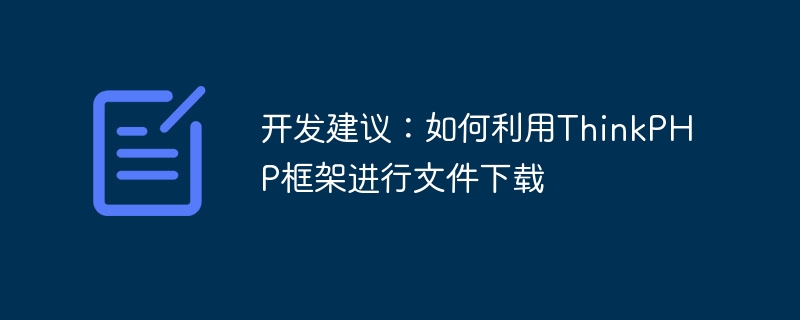

Development suggestions: How to use the ThinkPHP framework for file downloading
Introduction:
In modern web applications, file downloading is a common requirement . Whether it is downloading files uploaded by users, or providing downloads of log files or report files, it needs to be implemented through a back-end framework. This article will introduce how to use the ThinkPHP framework to implement the file download function.
1. Set up routing
First, we need to set up a route to handle file download requests. In ThinkPHP, you can add the following code to the routing configuration file (route.php):
Route::get('download/:id', 'index/DownloadController/download');In the above code, we define a route named download and pass a parameter: id. In this way, when the user accesses /download/1, the download method in DownloadController will be called.
2. Write a controller
Next, we need to write a controller to handle the logic of file downloading. In ThinkPHP, you can create a DownloadController controller in the following way:
<?php
namespace appindexcontroller;
use thinkController;
use think
acadeRequest;
class DownloadController extends Controller
{
public function download($id)
{
// 根据$id获取文件信息,例如文件路径、文件名等
$fileInfo = $this->getFileFromDatabase($id);
if (!$fileInfo) {
// 如果文件信息不存在,返回错误页面
return $this->error('文件不存在!');
}
// 获取文件路径
$filePath = $fileInfo['file_path'];
// 判断文件是否存在
if (!file_exists($filePath)) {
// 如果文件不存在,返回错误页面
return $this->error('文件不存在!');
}
// 设置下载文件的相关Header信息
header("Content-type: application/octet-stream");
header("Content-Disposition: attachment; filename=" . $fileInfo['file_name']);
// 读取文件内容并输出到浏览器
readfile($filePath);
}
private function getFileFromDatabase($id)
{
// 根据$id从数据库中获取文件信息,这里只是示例,具体实现根据实际需求来定
$fileInfo = [
'file_path' => '/path/to/file', // 文件路径
'file_name' => 'example.jpg' // 文件名
];
return $fileInfo;
}
}In the above code, we define a download method to handle the logic of file downloading. First, obtain file information from the database according to the passed id parameter, such as file path and file name. Then, determine whether the file exists, and return an error page if the file does not exist. Next, set the header information of the downloaded file, including Content-type and Content-Disposition, so that the browser will download the file as an attachment. Finally, use the readfile function to read the file content and output it to the browser.
3. Test file download
After completing the above two steps, we can test the file download. You can use the following code to generate a download link in the view file:
<a href="/download/1">下载文件</a>
In the above code, we use a URL such as /download/1 to access the file download route and pass the id parameter.
Conclusion:
Using the ThinkPHP framework to download files is a relatively simple task. By setting up routing and writing controllers, we can easily implement file download functionality. Of course, in actual development, other issues such as file permissions and file type checking also need to be considered. Here is just a basic example. I hope this article has provided some help for your development of ThinkPHP framework file download.
The above is the detailed content of Development suggestions: How to use the ThinkPHP framework for file downloading. For more information, please follow other related articles on the PHP Chinese website!